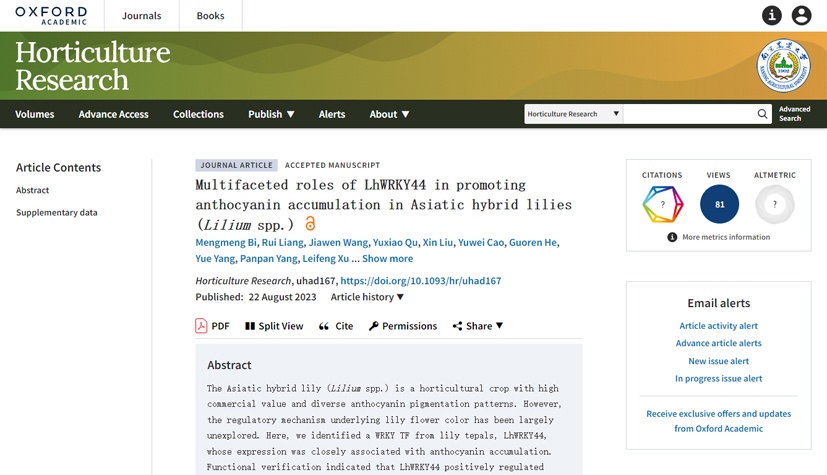Recently, the lily group of the Institute of Vegetables and Flowers published a paper entitled "Multifaceted roles of LhWRKY44 in promoting anthocyanin accumulation in Asiatic hybrid lilies (Lilium spp.)" in Horticulture Research (IF:8.7 Q1).

Lilies are among the most common and popular ornamental plants grown worldwide and have diverse floral colors. Anthocyanins, which are among the major pigments responsible for the colors of lily tepals, belong to the flavonoid family of plant secondary metabolites and mainly distributed in the vacuoles of plant tissues. In addition to determining the special colors of plants, these molecules act as protective substances that resist environmental stress, aid pollination and scavenge reactive oxygen species. The accumulation of anthocyanins in space and time leads to the different pigment patterns in lily tepals. In Asiatic hybrid lilies Tango Series lily cultivar, the specific accumulation of anthocyanins causes splashing spots at the base of the tepal. However, The accumulation of anthocyanins in space and time leads to the different pigment patterns in lily tepals. In Asiatic hybrid lilies Tango Series lily cultivar, the specific accumulation of anthocyanins causes splashing spots at the base of the tepal. However, the underlying mechanism of pigment pattern is still unclear.

Figure 1. The Asiatic hybrid lilies Tango Series cultivars.
Based on previous transcriptome data, we screened a WRKY TF LhWRKY44 from Asiatic hybrid Tango Series lily cultivar, which was closely related to anthocyanin accumulation. In this study, we characterized the roles of the LhWRKY44 gene and elucidated the mechanism in which anthocyanin accumulation was regulated by LhWRKY44. Transient overexpression and VIGS experiments confirmed that LhWRKY44 positively regulated anthocyanin accumulation in lily. The function was further verified in tobacco and apple calli. LhWRKY44 activated and bound to the promoters of the anthocyanin biosynthesis-related genes LhF3H and the intracellular anthocyanin-related glutathione S-transferase gene LhGST to promote anthocyanin biosynthesis. Moreover, LhWRKY44 physically interacted with LhMYBSPLATTER protein and directly bound to the LhMYBSPLATTER promoter, which enhanced the effect of the LhMYBSPLATTER-LhbHLH2 MBW complex activator on anthocyanin accumulation.

Figure 2. Characterization of the LhWRKY44 transcription factor.
The accumulation of anthocyanins in plant vegetative tissues and flowers is affected by internal factors and external environmental factors light, temperature, hormones, sugar, etc. Numerous evidences have shown that WRKY transcription factor play an important role in resisting environmental stress. Cis-element analysis of the LhWRKY44 promoter revealed a large number of light-responsive elements and stress-related elements. The expression of LhWRKY44 was induced by drought stress treatment. Further results showed that LhWRKY44 participated in light and drought-induced anthocyanin accumulation, and improved the drought tolerance in lily by activating stress-related genes. Additionally, we accidentally noted that overexpression LhWRKY44 confers early flowering in transgenic Arabidopsis. Thus, LhWRKY44 might serve as a major regulator that integrated the environmental signal pathway and development signal pathway to determine the level and patterning of anthocyanin accumulation in Asiatic hybrid Tango series lily cultivars. Our study expanded the understanding of the WRKY44-mediated transcriptional regulatory hierarchy modulating anthocyanin accumulation in Asiatic hybrid lilies.

Figure 3. LhWRKY44 interacts with LhMYBSPLATTER and enhances the interaction between LhMYBSPLATTER and LhbHLH2.
The Institute of Vegetables and Flowers of the Chinese Academy of Agricultural Sciences is the first unit to complete the paper. Dr. Mengmeng Bi of the Institute of Vegetables and Flowers, is the first authors. Prof. Jun Ming and Prof. Leifeng Xu are corresponding authors of the paper. This work was supported by the National Natural Science Foundation of China, the Programs for National Key R & D Plan.
Link:https://academic.oup.com/hr/advance-article/doi/10.1093/hr/uhad167/7247527?searchresult=1.